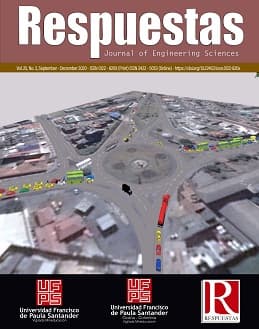Analysis and control of soil moisture through a system supported by sensors in the botanical garden “Jorge Quintero Arenas”
Análisis y control de humedad del suelo a través de un sistema soportado por sensores en el jardín botánico “Jorge Quintero Arenas”
Main Article Content
From new technologies that can be integrated without affecting the environment and generate various changes in the way of learning, solutions are proposed for continuous improvement, which in the end is done in favor of sustainability, quality of life and an intelligent botanical garden. This paper describes the development of a prototype sensor system created for soil moisture analysis and control. This prototype is made up of a network of sensors that will support the administration of the botanical garden. It was obtained the evaluation of the obtained variables and likewise, the approach of strategies with respect to the reduction of the waste of the hydric resource, all this focused on the use of the Internet of the Things (IoT). This is that by having a detailed knowledge of each of the variables that influence under the conditions established for this project, it was possible to achieve with greater ease and security the appropriate approach of strategies that allow water saving and avoid more effectively the waste of this resource so precious and necessary for consumption and also for saving money and better environmental quality.
Downloads
Article Details
E. V. Biswal, E. H. M. Singh, W. Jeberson, and E. A. S. Dhar, “Greeves : A Smart Houseplant Watering and Monitoring System,” vol. 4, no. 7, pp. 2499–2507, 2015.
A. H. Abbas, M. M. Mohammed, G. M. Ahmed, E. A. Ahmed, and R. A. A. A. A. Seoud, “Smart watering system for gardens using wireless sensor networks,” in 2014 International Conference on Engineering and Technology (ICET), 2014, pp. 1–5.
J. C. Lendemer and R. C. Harris, “The New York Botanical Garden Lichen Herbarium: A unique resource for fungal biodiversity research and education,” BRITTONIA, vol. 68, no. 3, pp. 334–340, Sep. 2016.
B. M. Thiers, M. C. Tulig, and K. A. Watson, “Digitization of The New York Botanical Garden Herbarium,” BRITTONIA, vol. 68, no. 3, pp. 324–333, Sep. 2016.
L. M. Campbell, “Collections in the Plant Research Laboratory of The New York Botanical Garden,” BRITTONIA, vol. 68, no. 3, pp. 341–347, Sep. 2016.
C. L. Wassenberg, M. A. Goldenberg, and K. E. Soule, “Benefits of botanical garden visitation: A means-end study,” Urban For. Urban Green., vol. 14, no. 1, pp. 148–155, 2015.
K. S. Walter, Computerized plant record systems for botanic gardens. ACADEMIC PRESS LIMITED, 1991.
L. D. Candia, A. S. Rodriguez, N. Castro, P. Bazán, V. M. Ambrosi, and F. J. Diaz, “Mejoras en maquinaria industrial con IoT: hacia la industria 4.0,” in XXIV Congreso Argentino de Ciencias de la Computación (La Plata, 2018)., 2018.
A. Rizal, S. Winardi, D. Supriyatno, B. Anindito, and W. M. Utomo, “DESAIN STNK DIGITAL DENGAN CHIP ESP8266 BERBASIS INTERNET of THINGS (IoT) DALAM ERA INDUSTRI 4.0,” in Seminar Nasional Ilmu Terapan (SNITER), 2018, vol. 1, no. 1, pp. C03--1.
A. Zambrano, M. E. Ortiz, M. Z. Vizuete, and X. Calderón, “Crowdsensing and MQTT Protocol: A Real-Time Solution for the Prompt Localization of Kidnapped People,” in The International Conference on Advances in Emerging Trends and Technologies, 2019, pp. 238–247.
R. Jesús, “Bluetooth HC-05 y HC-06 Tutorial de Configuración,” GeeKFactory. Recuper. http//www. geekfactory. mx/tutoriales/bluetooth-hc-05-y-hc-06-tutorialde-configuracion, 2014.
H. Susanto, R. Pramana, and M. Mujahidin, “Perancangan Sistem Telemetri Wireless Untuk Mengukur Suhu dan Kelembaban Berbasis Arduino Uno R3 ATmega328P dan XBee Pro,” Skripsi. Fak. Tek. Univ. Marit. Raja Ali Haji. Tanjung Pinang, 2013.
M. C. de la Piedra, A. G. C. Martinez, I. T. de Tuxtla Gutiérrez, J. A. L. Molina, N. A. M. Navarro, and J. O. G. Sánchez, “Modelo neurodifuso para el control de humedad del suelo en cultivo hidropónico para la planta de tomate.,” Rev. Tecnol. Digit. Vol, vol. 6, no. 1, pp. 43–56, 2016.
J. Lee et al., “Singlet exciton fission photovoltaics,” Accounts of Chemical Research. 2013.
M. H. D. A. Barkoosaraei and S. Moshiri, “Designing of Genow Botanical Garden with Sustainable Architecture Approach,” Tar. Kult. VE SANAT ARASTIRMALARI DERGISI-JOURNAL Hist. Cult. ART Res., vol. 6, no. 4, pp. 1211–1226, Sep. 2017.
A. Luvisi and G. Lorenzini, “RFID-plants in the smart city: Applications and outlook for urban green management,” Urban For. Urban Green., vol. 13, no. 4, pp. 630–637, 2014.
A. Agostini, G. Alenyà, A. Fischbach, H. Scharr, F. Wörgötter, and C. Torras, “A cognitive architecture for automatic gardening,” Comput. Electron. Agric., vol. 138, pp. 69–79, 2017.
S. Basuvaiyan and V. Rathinasabapathy, “IoT based Solar Photo Voltaic Monitoring System.” 2017.
F. Maciá, Smart University. Hacia una universidad más abierta, Primera. 2017.
M. Ali and A. Majeed, “How Internet-of-Things ( IoT ) Making the University Campuses Smart ?,” pp. 646–648, 2018.
S. Hipwell, “Developing smart campuses #x2014; A working model,” 2014 Int. Conf. Intell. Green Build. Smart Grid, pp. 1–6, 2014.
I. Staskeviciute and B. Neverauskas, “The Intelligent University’s Conceptual Model,” Inz. Ekon. Econ., no. 4, pp. 53–58, 2008.
J. Green, “The Internet of Things Reference Model,” Internet of Things World Forum, pp. 1–12, 2014.
J. G. Arévalo-Ascanio, R. A. Bayona-Trillos, and D. W. Rico-Bautista, “Responsabilidad social empresarial e innovación: Una mirada desde las tecnologías de la información y comunicación en organizaciones,” Clío América, vol. 9, no. 18, p. 180, Jul. 2015.
K. Dar, A. Taherkordi, H. Baraki, F. Eliassen, and K. Geihs, “A resource oriented integration architecture for the Internet of Things: A business process perspective,” Pervasive and Mobile Computing, vol. 20. pp. 145–159, 2015.




 Perfil Google Scholar
Perfil Google Scholar



